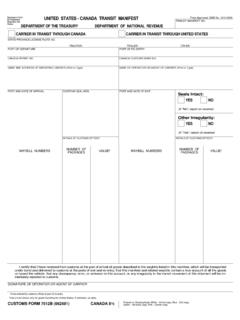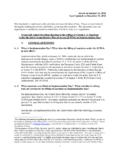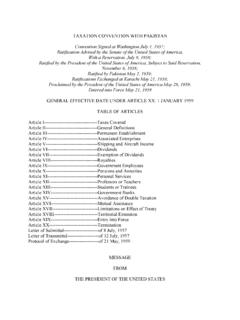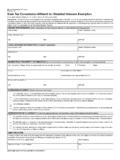Transcription of TREASURY DEPARTMENT TECHNICAL EXPLANATION OF …
1 TREASURY DEPARTMENT TECHNICAL EXPLANATION OF THE AGREEMENTBETWEEN THE GOVERNMENT OF THE united states OF AMERICAAND THE GOVERNMENT OF THE PEOPLE S REPUBLIC OF CHINA FOR THEAVOIDANCE OF DOUBLE TAXATION AND THE PREVENTION OF TAX EVASIONWITH RESPECT TO TAXES ON INCOMEGENERAL EFFECTIVE DATE UNDER ARTICLE 27: 1 JANUARY 1987 The Agreement, an accompanying Protocol, and an exchange of letters were signed inBeijing on April 30, 1984. Hereafter, the term Agreement refers to the three documents. Theterm "Agreement" has the same meaning as "Treaty" or "Convention", and the Agreement issubject to the same ratification requirements and has the same force as a Convention or Agreement is based on the model income tax conventions published by theOrganization for Economic Cooperation and Development in 1977, the united Nations in 1980,and the TREASURY DEPARTMENT in TECHNICAL EXPLANATION is an official guide to the Agreement.
2 It reflects policiesbehind particular provisions as well as understandings reached with respect to the interpretationand application of the OF ARTICLESA rticle 1---------------------------------Person s CoveredArticle 2---------------------------------Taxes CoveredArticle 3---------------------------------Defini tionsArticle 4---------------------------------Reside nceArticle 5---------------------------------Perman ent EstablishmentArticle 6---------------------------------Income from Real PropertyArticle 7---------------------------------Busine ss ProfitsArticle 8---------------------------------Relate d EnterprisesArticle 9---------------------------------Divide ndsArticle 10--------------------------------Intere stArticle 11--------------------------------Royalt iesArticle 12--------------------------------GainsA rticle 13--------------------------------Indepe ndent Personal ServicesArticle 14--------------------------------Depend ent Personal ServicesArticle 15--------------------------------Direct ors FeesArticle 16--------------------------------Artist es and AthletesArticle 17--------------------------------Pensio ns and AnnuitiesArticle 18--------------------------------Govern ment Employees and PensionsArticle 19--------------------------------Teache rs.
3 Professors and ResearchersArticle 20--------------------------------Studen ts and TraineesArticle 21--------------------------------Other IncomeArticle 22--------------------------------Elimin ation of Double TaxationArticle 23--------------------------------Nondis criminationArticle 24--------------------------------Mutual AgreementArticle 25--------------------------------Exchan ge of InformationArticle 26--------------------------------Diplom ats and Consular OfficersArticle 27--------------------------------Entry into ForceArticle 28--------------------------------Termin ationProtocol ---------------------------------of 30 April, 1984 Exchange of Letters--------------------of 30 April, 1984 ARTICLE 1 Persons CoveredThis article states the general rule that persons affected by the Agreement are residents ofthe united states or China or of both countries. The term "resident" is defined in Article articles may also apply to nonresidents; see, for example, Article 23, which concernsnondiscrimination, and Article 25, concerning exchanges of information.
4 Article 1 issupplemented by Articles 1 and 2 of the 1 of the Protocol provides that the Agreement does not restrict any benefitsprovided by the laws of either Contracting State or by any other agreement between theContracting states . This rule reflects the principle that a double taxation agreement should notincrease the overall tax burden which would result in the absence of the Agreement. Forexample, if the Agreement permits a Contracting State to tax an item of income which under thelaw of that State is exempt from tax, the statutory exemption applies. A taxpayer, however,may not make inconsistent choices between the rules of the Internal Revenue Code ("the Code")and the rules of the 2 of the Protocol is a simplified version of the traditional "saving clause" whichpreserves the right of the united states to tax its citizens and residents under its domestic rule is drafted unilaterally, as China does not tax on the basis of citizenship and does notconsider such a provision necessary to preserve its taxation of, and implement the Agreementwith respect to, Chinese residents.
5 The reference to "citizens" of the united states is understoodby the parties to include former citizens whose loss of citizenship had as one of its principalpurposes the avoidance of tax. Such former citizens are taxable in accordance with section877 of the Code. Certain benefits of the Agreement are available to residents, as defined inArticle 4 of the Agreement. Those benefits are the right to a correlative adjustment of taxliability as provided in paragraph 2 of Article 8, the exemption from tax of Chinese socialsecurity benefits provided in paragraph 2 of Article 17, the provisions concerning governmentemployees, teachers and students of Articles 18, 19 and 20, and the benefits of Articles 22, 23,24 and 26 concerning, respectively, relief from double taxation, nondiscrimination, the mutualagreement procedure, and diplomats. Further, it is understood that the benefits of the provisionsconcerning relief from double taxation, nondiscrimination, and the mutual agreement procedurewill also be available to nonresident citizens to the extent applicable under the specificterms of those 2 Taxes CoveredParagraph 1 of this article enumerates the existing taxes to which the Agreement appliesin each Contracting State.
6 In the united states , these are the Federal income taxes imposed bythe Code. As explained in Article 3 of the Protocol, social security taxes are not covered bythe Agreement. The personal holding company tax and the accumulated earnings tax are also notcovered by the Agreement, except that they will not apply to a Chinese company which is whollyowned, directly or indirectly, by individual residents of China who are not citizens or by theGovernment of China or a wholly owned agency Chinese taxes covered by the Agreement are the individual income tax, the incometax concerning joint ventures with Chinese and foreign investment, the income tax concerningforeign enterprises, and the local income 2 provides that the Agreement shall also apply to taxes imposed after the dateof signature of the Agreement, provided that they are substantially similar to those enumerated inparagraph 1.
7 The competent authorities agree to notify each other of substantial changes in theirrespective income tax 3 DefinitionsArticle 3 defines some of the principal terms used throughout the Agreement. Unless thecontext otherwise requires, the terms defined in this article have a uniform meaning throughoutthe Agreement. A number of important terms are defined in other articles. For example, the term"resident of a Contracting State" is defined in Article 4, and the term "permanent establishment"is defined in Article 5. The terms "dividends," "interest," and "royalties" are defined in Articles9, 10, and 11, geographical territory of the two Contracting states is defined to include theircontinental shelf areas to the extent consistent with international law and their respectivedomestic laws. Thus, for example, activities taking place on the seabed or subsoil beyond theterritorial sea of the united states will be considered to take place within the united states forpurposes of the Agreement, provided that the united states has jurisdiction over such areas inaccordance with international law and domestic law.
8 The united states will interpret thisdefinition in accordance with section 638 of the Internal Revenue Code and the regulationsthereunder. The " united states " does not include Puerto Rico, the Virgin Islands, Guam, or territory or possession. The "People's Republic of China" does not include Hong Kong, asChinese tax laws are not in effect there. Moreover, in accordance with the Agreement betweenthe united Kingdom and China on the future of Hong Kong, the taxes imposed by the HongKong Special Administrative Region will continue to be independent of the tax laws of theCentral People's Government, and therefore the Agreement will not apply to Hong Kong evenafter term "person" includes an individual, a company, a partnership, and any other bodyof persons. It also includes, as provided in Article 4 of the Protocol, an estate or a trust. The term"person" is important because the Agreement applies to "persons" who are residents of one orboth Contracting states and residence in a State is defined in terms of "persons" meeting certaincriteria.
9 A company is any entity treated as a corporation for tax term "nationals" means individuals having the nationality of a Contracting State andlegal entities deriving their status as such from the law in force in a competent authority in the case of China is the Ministry of Finance or its authorizedrepresentative and in the case of the united states is the Secretary of the TREASURY or hisauthorized 2 provides that, in the case of a term not defined in the Agreement, thedomestic tax law of the State applying the Agreement shall control, unless the context requires adifferent interpretation or unless the competent authorities agree on a common meaning inaccordance with paragraph 3 of Article 24 (concerning the mutual agreement procedure).The Agreement does not include a definition of the term "international traffic" becausethat definition, as well as the substantive rules concerning the taxation of international shippingand air transport income, is contained in the Agreement Between the Government of the UnitedStates of America and the Government of the People's Republic of China with Respect to MutualExemption From Taxation of Transportation Income of Shipping and Air Transport Enterprises,which was signed on March 5, 1982 and entered into force on September 23, 4 ResidenceThis article defines those persons who are residents of a Contracting State and thusentitled to the benefits of the Agreement.
10 The definition begins with a person's liability to taxunder domestic law. Paragraph 1 lists several criteria which may be used in domestic law todetermine residence for tax purposes. Citizenship is not one of the criteria; thus a citizenresident in a third country is not treated as a resident for purposes of this Agreement. Thereference to persons "liable to tax" is not meant to exclude organizations of either country whichare tax-exempt under special provisions of its domestic law, such as charities. However, it wouldnot include a person liable to tax only in respect of income from sources in the taxing country,such as a resident of a third country subject to tax in the united states or China only on a sourcebasis. A partnership, estate or trust is a resident only to the extent that the income it derivesis subject to tax either in the hands of the entity or of its partners or 2 provides that, where an individual is considered to be a resident of bothContracting states under their respective domestic laws, the competent authorities shall consulttogether to determine of which State the individual shall be a resident for purposes of theAgreement.














